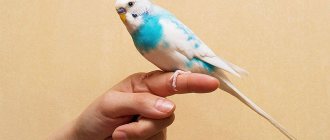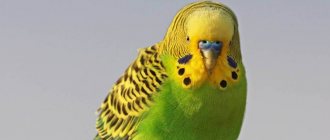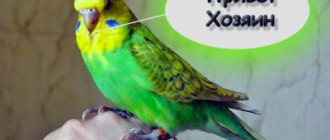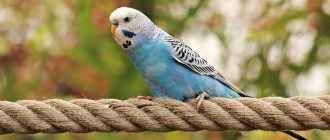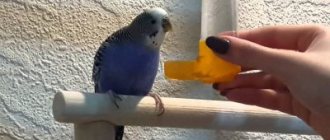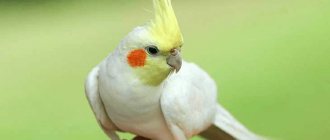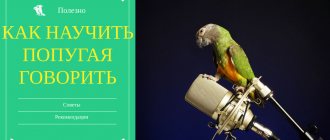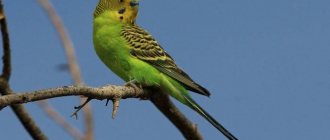Parrots are extremely social creatures that cannot tolerate loneliness or boredom.
All social beings must communicate with each other. Most animals do this through body language—barely noticeable to us humans. This is an ancient class of birds that, unlike other animals, has a unique vocal apparatus.
This vocal apparatus and amazing brain help parrots pronounce any difficult sounds, including imitating human speech. This allows birds to communicate not only with their relatives, but also with people.
What parrots can talk: types of talking parrots
If you want to get a chatty bird, you should carefully approach even such an initial stage as purchasing it. The choice may be difficult. However, it should be taken into account that some breeds are better suited for aesthetic perception, while others perfectly imitate sounds. We are interested in the latter.
The Gray Gray may not boast bright plumage, but he can learn more than a hundred words. Or it will even play phrases. This bird’s ability to imitate is amazing: it can both imitate the timbre and intonations of a person and sing ! According to research, the brain of an adult bird is at the same level of development as the brain of a five-year-old child.
The gray gray parrot is dim, but very talkative
IMPORTANT: If you want to become the owner of a parrot that will speak almost the same as a person, then a gray Gray is what you need. However, keep in mind that only a young bird can be tamed, and it will have to be taught to speak from the age of the chick.
As for the maintenance, the Gray will not cause any trouble. But it should be taken into account that his character can be harmful - he can worry, scream, be offended and takes a long time to get used to the new environment. Always wants to be a leader, and persistently wins leadership positions. But if you manage to get along with a wayward pet, be sure that he will reciprocate.
You may be tempted to buy an already talking adult bird for around $1,000 , but it is still recommended to buy a young Gray. He will not be able to speak, but it will not be difficult to teach it. And this option costs twice as much.
It is better to buy a baby gray parrot
Amazons are rightfully considered the most easily trained large birds . They are able to remember on average 50 to 60 words. They pronounce them legibly, but they cannot copy the timbre and intonation of a person. But self-education is not alien to these birds.
The Amazons will also delight you with their bright plumage. Their feathers are a rich green color combined with blue, yellow, red and white splashes.
Unlike the Gray Gray, the Amazon will quickly get used to its new home and owner . He will not make trouble or make other noises, and he will be very attached to people. Moreover, the latter means that the pet will need to pay maximum attention.
IMPORTANT: But there are also difficulties. Thus, Amazons do not tolerate drafts well, so their living conditions should be as comfortable as possible.
You can buy a young parrot that cannot talk for half the price than an older one that can communicate. The latter, like the Gray, costs about $1,000.
Amazon is a bright and talkative parrot
Cockatoos quickly learn words, which can be learned by several dozen. They pronounce them legibly, and even imitate the style of speech of the person who is training. songs from the side of the cage , then do not be surprised - the cockatoo is also inclined to such things.
This bird is unpretentious in keeping and at the same time good-natured towards people. The plumage is bright , so the eye will have something to rest on. The sociability and responsiveness of the pet contributes to its rapid learning.
IMPORTANT: However, the sociability of the cockatoo may not be to everyone’s taste, given that it often demands attention with loud cries. An overly energetic bird rarely allows you to sit in silence.
The price for it ranges from 1000 to 2500 dollars . It does not depend on how trained the cockatoo is.
Sociable and loving to talk cockatoo parrot
The macaw is a parrot for true aesthetes. He looks exactly like the first association when hearing the word “parrot” - colorful plumage and graceful movements. The macaw never screams for no reason , does not fuss and is not capricious about caring for him.
As for learning, the macaw is considered an intellectual - even though he is most often able to learn about 20 words, but at the same time the words will be used where necessary. The pet will be able to build an associative chain and connect words with events.
There is another interesting feature - the macaw often reproduces the sounds it hears in addition to human speech. This means barking, squeaking, coughing, and so on.
IMPORTANT: As for the price, it can be slightly higher than for other parrots, and reach $3,000.
The Macaw is a colorful and intelligent parrot.
Budgerigars are the most common breed of chattering parrots in Russia. True, they do not always reproduce words clearly, but this is more than made up for by their desire for learning and communication . A chatterbox parrot needs 10-20 words to communicate with people. However, you can try to include more terms in his vocabulary.
Budgerigars are not picky people ; anyone can take care of them. Easily adapting to a new home, they play and fly with great eagerness, causing indescribable delight among children.
As for color, there is amazing variety. You can purchase both a single-colored parrot and a variegated one - in total there are about 200 combinations to choose from! The sizes are also different.
This happiness will not cost much - about 20 dollars.
Budgerigars are colorful and chatty pets
Corella - unlike the budgerigar, this species pronounces words more clearly. And their vocabulary may be richer - for example, if you take learning seriously, it is quite possible to add 200-250 words to it! It is also very popular in our country.
He loves society very much and listens with pleasure to what he is told.
IMPORTANT: True, despite all this, when training a cockatiel you will have to stock up on a fair amount of patience.
Cockatiels - this parrot is not as easy to train.
Lori - responds well to training, remembering about 70 words . It is easy to tame them, receiving sincere friendliness in return. These birds are very lively and active.
The brightness of the plumage and the tendency to learn often make one want to immediately purchase a loris. However, it is important to immediately understand that it is difficult to keep them - you will have to carefully select food and constantly monitor the temperature.
Lori parrot - sociable but capricious
Indian collar worker - able to memorize impressive amounts of text, while pronouncing words clearly. There is a legend that birds were once kept by monks, and their pets repeated prayers. It is these parrots that are able to read excerpts from books and poems.
Just a great find for those people who are looking for a medium-sized bird that loves to chat.
IMPORTANT: It is worth considering that these birds need spacious enclosures to feel comfortable. They need to fly often - only then will you get a diligent student.
The Indian collared parrot has a unique memory.
Quakers - they are much smaller than Grays or Amazons, but are quite talkative. Quakers can repeat both words and a variety of everyday sounds. They are sociable, playful, energetic, and curious. These pets will be truly attached to their owners.
Quaker is a loyal and sociable parrot.jpg
Eclectus is a good purchase for those people who want to have not only a talking, but also a large parrot with bright plumage . If training is properly organized, the parrot will imitate human speech well . True, for this you will have to be patient and stick to the class schedule.
Eclectus is a large and sociable parrot
IMPORTANT: All of the listed types are trainable. Only some birds grasp information faster, and some more slowly. Moreover, in each of the described breeds there are both talented representatives and mediocrities. Therefore, you should not buy a bird with the thought that you are guaranteed to have a chatterbox parrot.
Description
Body length and weight depend on the subspecies, but in general cockatoos are large parrots from thirty to seventy centimeters. Weight also ranges from 500 grams to 1200 grams.
Elongated feathers on the crown and forehead create a beautiful crest. Usually it contrasts in color with other plumage; the color contains various colors and their shades: white, red, pink and even black. The crest is not only a decoration, but by it the owners will be able to understand the mood of the pet, because it funnyly raises, lowers, and ruffles it.
The beak is considered a striking feature of the cockatoo. It is massive, curved, long, and bucket-shaped. This structure is found precisely in this species of parrots. At the same time, the beak is very powerful and strong, a bird can easily use it to turn branches into splinters, and your fingers will also be in trouble if the cockatoo suddenly bites.
The tip of the fleshy tongue is covered with a dark cornea, and a special hollow allows the cockatoo to use its tongue almost like a spoon.
The bird has "rings" around its eyes, which may or may not be covered in feathers.
Cockatoos fly well, but they love to climb, and they also move well just on the ground.
The cockatoo also differs from many other parrots in that it is not green in color.
In total, today there are more than 20 species of cockatoos, among the most famous: Yellow-crested, Jolucca, White-crested, Pink, Major Mitchell's cockatoo and Goffin's cockatoo.
At what age do parrots start talking?
It will not be possible to determine a parrot’s ability in a store, but to increase the likelihood of successful training, it is recommended to pay attention to the age of the bird. Considering that a parrot lives on average 10-12 years, its childhood lasts 28-35 days. This is the month-old parrot you need - young ones are much easier to teach.
There are, of course, cases of parrots that are several years old learning to speak. Of course, it is possible to start training at a late age, but a positive result will most likely be the exception. Experts say that the situation with parrots is the same as with children - the earlier you start learning something, the better the result will be.
IMPORTANT: If you start training your pet as early as possible, then already at 2 months he will begin to clearly imitate a person. By the age of one year, the vocabulary can reach hundreds of words and phrases - this is a particularly active period. At 2 or 3 years old, the bird will already be able to recite poetry or compose long sentences. Of course, these data are conditional, but they well illustrate what can be achieved by training a parrot from an early age.
It is best to start teaching a parrot to speak at one month of age.
Talk to Gray
“African gray parrots have a reputation for being smart and not loud,” Matti Sue Athan, a parrot behavior consultant for the International Association of Animal Behavior Consultants (IAABC), and author of “The Behaved Parrot,” said in an interview.
Atan reported that independent development of playing skills also affects the development of the bird’s vocal abilities. Special toys for birds, intensive training, which the bird masters in the period between the appearance of plumage and the onset of puberty, is the key to a well-mannered parrot with good vocal and conversational abilities. If the Gray is deprived of privileges with toys, then this may later affect his behavior - excessive loudness and destructive behavior in general.
On video: talking gray parrot
The owner of a gray gray cat named Rocket was amazed by his ability to learn new words every week, and now she knows exactly which parrots speak best. She said that he is prone to self-learning : “Once Rocket spied on me while eating food, and suddenly said: “I want some...”. I told him: “Rocket, go eat your grain.” He continued to insist: “I want some...”. Then he started doing what I call a somersault. It went up the front of the cage to the top, and down the back wall. He saw that his trick still didn’t work (and it was thanks to her that he always got what he wanted before). And when I again repeated that he should go eat his bird food, he said: “I want food... Please!” I was amazed at his persistence, and besides, he had never used the word “Please” before. Of course, Rocket will get his share of goodies."
Another owner of a Gray Gray, who currently has a vocabulary of 300 words, said that when the bird was brought from a pet store at the age of 4 months, she immediately greeted the owner with the word: “Hello.” The parrot said hello every time he saw a person. And a little later, he often mixed different words with the name of the mistress, teased her and laughed. “He knew he was joking and entertaining me. It was great,” says the owner. “He also learned several songs, and if you start singing the first verse, he will definitely sing along with the second.”
Is it possible and how to teach a parrot to talk in 5 minutes?
Despite the fact that the degree of talent for each bird is different, in any case you will need to spend a lot of time on training . Statistics show that in order for a pet to clearly learn the first word , you need to spend three weeks.
Systematicity is also extremely . It is advisable to conduct classes not just daily, but several times a day . So, in the morning before feeding your pet, you should allocate 10-20 minutes for training, in the afternoon - 35-40 minutes , in the evening - again 20 minutes.
As you can see, it’s impossible to make a speaking bird out of an ordinary bird in 5 minutes , just as it’s impossible to teach a lot of words in one sitting. You can only, if you don’t have enough time, conduct small lessons . For example, first let your feathered friend learn his name. Parrots respond extremely favorably to hissing sounds, so nicknames like Cash and Nyusha are ideal.
Monosyllabic words are also great to learn at the beginning. For example, the word “food”, pronounced simultaneously with holding out a treat. In general, it is worth paying attention to words containing the sounds “a”, “o”, “p”, “r”, “t”.
IMPORTANT: The parrot must be given time to remember the word, at least a few seconds. You can start with sounds - it won’t take much time, but it will benefit your pet.
Be sure to give your parrot time to memorize the word or sound.
Remember the four rules!
- The bird hears not only the teacher’s voice, but also those numerous overtones that accompany our life. Household appliances are running, the elevator is grinding on the landing, music is playing from the neighbors. This all adds up to pronunciation, because the student is too diligent, he also copies extraneous inclusions that we do not notice. If you ensure that there is no noise interference during training, your pet will speak more clearly.
- The teacher also needs to monitor his diction without losing the emotional content of everything he says.
- Females study less willingly, take longer, but speak more clearly than males.
- Of course, it is necessary to correct what is not pronounced clearly enough. This is done step by step, when the teacher pronounces the word many times with emphasis first on the first syllable, then on the second, as if “emphasizing” a sound that does not work.
Read also
Kakapo parrot
How to teach a boy budgie to talk?
The most important rule that you need to learn from the beginning is that you should never yell at your parrot. It definitely won’t get better, but it could easily get worse. It is extremely important to establish a trusting relationship with the bird and try not to offend it.
The room in which lessons are held should be comfortable and quiet. Remove all the people and birds from there: if several people start training a parrot at the same time, it will become confused, and if several parrots start chatting nearby, it will become distracted.
IMPORTANT: It is believed that the parrot is best inclined to learn words in the dark - it is not too active then.
Do not try to start training in the very first minutes after acquiring a new family member. Keep in mind that he needs to get used to you. Do not let the bird out of the cage at first, talk to it tenderly, bring your hand up slowly and carefully. Ideally, you should start training only on the second or third day after purchase.
Be sure to praise the bird by offering him a treat. Moreover, it is worth doing this by hand - this way the pet’s trust will only become stronger.
During the learning process, a parrot must be rewarded with treats.
It is worth choosing one person who will conduct the training. It is believed that parrots best perceive children's or women's voices - in a word, a high timbre of the voice.
IMPORTANT: Have your chosen teacher teach at the same time of day on a regular basis. And don’t be afraid that nothing will work out - the first word, as a rule, always takes the longest to learn. Then things should get better.
Try to develop regularity even in the case of intonation - the bird picks it up unmistakably. By the way, you should also praise in such a way that the student understands by intonation that they are satisfied with him.
At the same time, work diligently to ensure that your pet seeks your company. This is not so difficult to do, because budgies need constant contact. It is highly desirable that the bird gets used to sitting on your hand - this is a clear signal that it is ready to listen. However, at first you just need to carefully bring your hand to the perch and lure it with food.
The parrot must get used to sitting on its owner's hand.
How do you know that your lessons are not in vain? If the student freezes on the perch or hand, while looking into the person’s mouth , everything goes as it should. When listening, the bird's pupils alternately narrow and dilate. Pronounce sounds or words loudly and clearly .
Please note that the parrot perceives best those words that are characterized by emotionality in pronunciation. These could be exclamations or questions. For example, for starters, when entering a room, you can clearly say the word “hello!” every time.
IMPORTANT: Parrots are like children. You should never utter swear words in their presence, otherwise you risk one day receiving this obscenity in response.
A parrot's good mood is a guarantee of fruitful lessons. Treat your pet with a bell hanging on a string. And it is extremely necessary to have a mirror - birds love to talk to their reflection. The latter, by the way, will serve as excellent training.
Parrots love to talk to their reflection
New words are certainly good, but it’s worth remembering the old ones too. The fact is that the parrot tends to exclude from its memory already learned words that are no longer repeated. Many bird owners, in their pursuit of developing a large vocabulary for their pet, often forget that repetition is the mother of learning.
Try to conduct training so that your or the parrot’s actions coincide with the word you offer. For example, if you see Kesha stretching, clearly say the word “stretch”. When leaving, do not forget to say goodbye to the bird. Over time, the feathered friend will begin to realize that words and actions are somehow interconnected.
You should not insist on training if you see that the parrot is completely lacking in concentration. The best way out in this case is to simply wait and give the bird the opportunity to do its own thing.
If your budgie wants to play, postpone the lesson for another time.
IMPORTANT: Long words and phrases should be saved for later lessons. In general, it is advisable to prepare a certain set of phrases and vary the words from it in different orders.
Macaw
The talking macaw parrot is an incredibly beautiful and intelligent creature. Macaws are similar to the parrots that are depicted in cartoons. Representatives of this breed have the strongest beak.
They can’t learn many words – about two or three dozen. But they have an amazing feature - it seems as if a person is really conducting a dialogue with a bird. Parrots are known to only repeat rather than analyze dialogues. But macaws create a truly intelligent appearance, and their peculiar intonation conveys a kind of interest in conversation.
They are quite loud and noisy, capricious, but at the same time obedient and easy to care for. They are quite expensive, since their numbers are quite small.
Is it possible and how to teach a girl budgie to talk?
Female budgerigars tend to cost less . However, there is an opinion that they are less trainable than males. There is some truth in this statement, since the speech abilities of girls are indeed limited.
However, ladies most often pronounce words more clearly . You may spend more effort on training, but as a result you can become the owner of a clearly speaking bird.
As for training technology, there is no particular difference between training for boys and girls . The female is the same parrot with the same physiological structure. The whole nuance lies in behavioral psychology.
IMPORTANT: Unlike a boy, a girl has a need not to strive to be liked, but to make a choice. This means that in this case it is the owner who must please the parrot - only in this way will there be a chance to become a good teacher.
A girl budgie should become interested in her owner herself
Amazons are good communicators
The Amazon family includes several species that are gifted talkers. Amazons are easily identified by their predominantly green plumage with color variations of red, yellow, blue and orange on their heads, wings and tails.
The most talking parrots of this family:
Yellow-necked Amazon. The ability to reproduce speech manifests itself even faster than the bird’s quarrelsome nature. They can begin to speak like children and can learn hundreds of words. If you want a bird that talks and are willing to deal with its demanding personality, then this is the parrot for you.
Amazon with a yellow crown. Yellowcrowns are excellent talkers, but may not be as proficient with words as yellownecked Amazons.
White-fronted Amazon. Also valued for its ability to speak. It is friendly, hardy, easily tamed and amenable to training.
How to choose a budgie to talk?
We mentioned above that it is worth purchasing a young individual . Its signs:
- Stripes are clearly visible on the head, forehead and back . They are present until the first molt, that is, up to 5-6 months . After it, the clarity of the lines of the drawing is lost.
- Black eyes. A light border and colored iris are characteristic of older birds.
- Short tail. It grows to our usual size after 2 months.
- Faded feathers and dark beak. In adults, the opposite is true.
The budgerigar chick has faded plumage and a bright beak
IMPORTANT: There is an opinion that talkative parents produce equally talented chicks. You can, of course, try to verify this information, but you should not consider it the ultimate truth.
Now let's learn to distinguish a boy from a girl. Look at the area above the beak; the nostrils are still located on it. It is called a cere:
- In boys, the cere is blue, bluish-purple or blue. Moreover, the shades can vary from very pale to the brightest.
Boy budgies have blue or blue cere
- For girls , this place is painted in brown and beige tones.
However, during molting, the cere of young ladies often turns blue, so it is quite easy to make a mistake in the choice. To avoid this, it is best to ask the seller when the last time your parrots moulted. In females, the previous wax color returns after 2 or 3 months.
Female budgies have a beige cere.
But we remember that it is advisable to buy a bird before it is 2-3 months old. In this case, only a specialist can help determine the gender.
Pay special attention to exactly how the birds are kept. It is advisable to come directly to the breeders, since transportation to the market can mentally traumatize the parrot. A cramped cage and the presence of other brothers in them also often has a negative effect.
IMPORTANT: Observe the behavior of the chick. An aggressive parrot is the least likely choice for you. In addition, the weaker representative will quickly see you as a leader and want to obey in everything. But it is also not recommended to take a chick that is too weak.
The parrot recognizes the leader in the man who left him
What is the price?
You can buy cockatoos both from breeders and secondhand. Of course, it is worth paying great attention to the health of the bird; it is important that the cockatoo undergoes an ornithologist examination and a laboratory check-up once a year, so that you can be confident in its condition when purchasing.
The price will depend on the subspecies of parrot. It starts from 50 thousand rubles, the highest level can reach 250-300 thousand rubles, some even call the cost up to 500,000 rubles. In general, prices from breeders typically range from $700 to $2,000.
You can purchase a parrot from private individuals for 5,000-10,000 rubles.
On our website there are more than 3260 veterinary clinics in Moscow for you on our website
How to teach a cockatiel parrot to speak?
As with the budgie, the cockatiel must trust its owner completely. A bird's good mood and well-being are also the key to its successful learning. In general, the principles of training a cockatiel are the same as for a budgie.
Cockatiels are famous for their mastery of copying tunes. And, in general, the only thing that is needed for this is to let the bird listen to some kind of melody more often.
It is not difficult to identify the musical cockatiel - you just have to listen to the squeak of the chick. The notes in it reveal a talented student. But any talent needs to be spurred on - in the case of a cockatiel, this can be done by treating it with sunflower seeds.
IMPORTANT: If this bird likes a certain melody, then get ready for the fact that you will listen to it constantly. So choose something unobtrusive. And don’t be surprised if your pet suddenly imitates the sound of a bark or a food processor.
According to statistics, out of 1000 young cockatiels, 872 can be taught to speak. However, if after 2 months of persistent and regular training there are no results at all, most likely you have come across a poor student.
If you want to have a melodious bird, buy a cockatiel
How to quickly teach a parrot to speak: phrases
We bring to your attention a list of useful or simply funny phrases that you can teach a bird:
- be healthy
- Behave yourself
- Everything will be fine
- Turn on TV
- Gosha is good
- Where's my present?
- Good morning
- Good evening
- Let `s play
- Close the window
- How are you doing?
- Chase the cat away
- Are you happy with me or not?
- I want to drink
- Want to eat
- I'm watching you
- Nerve cells do not recover
- Chita-drita, chita-margarita
- The birds are all on a branch, and I, poor thing, am in a cage
Audio recording for teaching a parrot to talk
The idea of placing a player near the cage to play phrases often comes to the owners of birds. How correct is this? Definitely, such tactics can also bring results - the bird will reproduce what it has heard many times.
IMPORTANT: However, the pet will be much more willing to learn with an owner he trusts, rather than with a technique. Parrots generally have a very hard time enduring loneliness.
However, if you are still in the same room with your pet when you turn on the recording, you can sometimes use this method of training. The fact is that if the bird remembers the phrases heard thanks to the recorder, it will become so accustomed to talking alone that it simply will not want to do this next to you. But it is dialogue that is important.
The parrot still prefers to have a dialogue with its owner
But if you are still determined to conduct a couple of lessons using a voice recorder, at least wait until the time when the parrot has a few words in its arsenal. And then you can use this advice:
Whatever type of parrot you decide to purchase, remember that in any case you will have to spend a lot of time and patience on training. And there is no guarantee that you have come across a smart Kesha. However, try and, perhaps, after a while you will be able to deservedly be proud of being the owner of a well-trained pet.
Common mistakes and some recommendations
- How to quickly teach a parrot to talk? The answer is no. Want to know why? Teachers often lack the patience to teach for months without results. But the results do not come gradually, but in spurts. Your feathered pet can listen and remain silent for a long, long time, and then immediately give out a set of phrases if the teacher does not give up.
- You can often hear the phrase “my parrot can’t talk.” Here we need to remember that there are no bad students, but only bad teachers. If your pet does not speak, ask yourself what you are doing wrong, think about how best to adjust the teaching method instead of looking for the reason in it.
- Can I teach a parrot to speak if I have a female or an adult bird? Both males and females can be taught human speech. It is easier to train chicks, but you can also train an adult parrot.
- Don't start the lesson if you're not in the mood. It's better to miss a class than to spend it in a bad mood.
Instead of concluding, I would like to say - don’t expect quick results. Parrots have many other valuable qualities for which they can and should be loved, even if the parrot does not speak at all!
